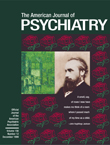Tiagabine and the Treatment of Refractory Bipolar Disorder
To the Editor: Gabapentin and lamotrigine have been recently introduced as add-on medications for the treatment of partial seizures. Several case reports and open studies in the psychiatric literature indicate that these two newer anticonvulsant drugs show promise in the treatment of bipolar disorder (1). Another anticonvulsant used for the treatment of partial seizures, tiagabine, was recently approved by the U.S. Food and Drug Administration (2). We report a positive response to tiagabine as an add-on agent in two patients with refractory bipolar disorder. Both patients gave written informed consent to take tiagabine for a non-FDA-approved indication.
Ms. A was a 46-year-old woman with a 23-year history of bipolar disorder type I with rapid cycling. Her illness had been difficult to manage. She had used the following medications in varying combinations and doses: lithium carbonate, imipramine, fluoxetine, divalproex, sertraline, gabapentin, clonazepam, alprazolam, thioridazine, risperidone, olanzapine, thiothixene, lamotrigine, and quetiapine.
Ms. A was taking a combination of quetiapine, lamotrigine, and alprazolam. This combination was initially effective; however, about 6 months later, she began to experience an increasing recurrence of mixed and manic symptoms. We elected to begin a trial of tiagabine. Her quetiapine therapy was discontinued and replaced with tiagabine, beginning at 1 mg/day (one-fourth of a 4-mg tablet) because she had a history of marked sensitivity to psychiatric medications. Lamotrigine and alprazolam treatment was continued. In response to the tiagabine, Ms. A commented that her mood was better than it had been in years. Her sleep was consistent, she was cognitively sharp, her energy and motivation were markedly improved, her dysphoria and anhedonia were resolved, and she could experience happiness. After 2 months of taking an average of 3 mg/day of tiagabine, she began to experience a manic episode. Restabilization was finally accomplished by increasing the tiagabine to 4 mg/day. She continued to experience benefit from tiagabine after 5 months. Her other psychiatric medications were lamotrigine (6.25 mg/day) and alprazolam (0.75 mg at bedtime) for insomnia.
Ms. B was a 42-year-old woman with a 6-year history of bipolar disorder type I. Her treatment course was initially turbulent. She was treated with the following medications in varying combinations and doses: lithium, temazepam, trazodone, amitriptyline, diazepam, sertraline, bupropion, paroxetine, fluoxetine, nortriptyline, divalproex, carbamazepine, flurazepam, and gabapentin. She was stabilized with a combination of lithium, venlafaxine, and flurazepam. Although she continued this combination therapy for several years, repeated occurrences of manic symptoms required adjunctive treatment. The following adjunctive medications were used without success: clonazepam, risperidone, haloperidol, lamotrigine, thioridazine, olanzapine, primidone, and quetiapine.
When Ms. B continued to experience marked recurrences of manic symptoms, we began a trial of tiagabine. Like Ms. A, Ms. B was sensitive to psychotropic drugs and was therefore started on the same low initial dose of 1 mg at bedtime. She gradually increased the dose to 4 mg at bedtime. She experienced no side effects and was able to lower her dose of flurazepam. Mood response was quite good; there was a marked reduction of manic symptoms. She took tiagabine for at least 3 months and was satisfied with the improved control of her manic symptoms. In addition to tiagabine, her other psychiatric medicines were venlafaxine (25 mg/day), lithium (300 mg/day), and flurazepam (7.5 mg at bedtime) for treatment of insomnia.
To our knowledge, these are the first case reports of the successful use of tiagabine as an augmenting agent for bipolar disorder. Tiagabine is a γ-aminobutyric acid uptake inhibitor that is metabolized by the liver. Most studies of the use of tiagabine for epileptic patients indicate that it is usually well tolerated (3). One report emphasized that a group of patients with epilepsy and psychiatric disorders (including depression) tolerated tiagabine as well as a group of patients with epilepsy without a history of psychiatric disorders (4).
The therapeutic range for tiagabine plasma concentrations has yet to be established. Our patients responded to a low dose of tiagabine compared to the doses required for seizure control in patients with epilepsy, according to the neurological literature. In our experience, psychiatric patients tend to respond to lower doses of anticonvulsants than patients with epilepsy. It is hoped that this encouraging response to tiagabine in two patients can be duplicated in other patients with refractory bipolar disorder.
1. Gelenberg AJ: New anticonvulsants in bipolar and other psychiatric disorders. Biological Therapies in Psychiatry Newsletter 1997; 20:21–23Google Scholar
2. Tiagabine for epilepsy. The Medical Letter 1998; 40:45–46Google Scholar
3. Leppik IE: Tiagabine: the safety landscape. Epilepsia 1995; 36(suppl 6):510–513Google Scholar
4. Krauss G, Carlson HA, Deaton R, Summerville KW: Beneficial results of tiagabine therapy in patients with psychiatric history (abstract). Epilepsia 1997; 38(suppl 8):105Google Scholar



